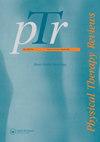为什么我们忽视了膝骨关节炎患者的核心肌群?文学的叙事性评论
IF 0.8
Q4 REHABILITATION
引用次数: 1
摘要
膝关节骨性关节炎损害患者的正常功能,特别是影响他们无限制行走的能力。对其他有膝盖损伤风险的人群的研究,包括年轻、活跃的人群,已经考虑到了核心肌肉。膝关节骨关节炎的治疗方案传统上是针对关节和四肢的。本叙述性文献综述的目的是确定:1)核心训练是否对无膝骨性关节炎的老年人有益,2)核心激活和/或稳定是否已纳入膝骨性关节炎患者的治疗建议,以改善其步态和功能能力。尽管核心训练对老年人的平衡、跌倒风险和活动能力是安全且有益的,但治疗膝关节骨性关节炎的标准护理方法仍然是关节/四肢特定的或广义的,包括更多的全身活动(如心血管训练)。一些早期证据显示核心力量和腹横肌完整性之间的关系;然而,使用核心激活和/或稳定作为膝关节骨性关节炎患者的干预措施尚未见报道。结论:尽管研究结果表明,核心训练对其他有各种膝关节疾病风险或正在康复的人群有益,但研究表明,核心训练对老年人安全有效,尚未被纳入膝关节骨关节炎患者的治疗建议。早期结果表明,核心肌肉尺寸、力量和膝关节骨关节炎之间存在关系;然而,目前还没有发表任何介入研究。并指出了该领域今后的研究方向。本文章由计算机程序翻译,如有差异,请以英文原文为准。
Why are we neglecting the core muscles in patients with knee osteoarthritis? A narrative review of the literature
Abstract Background Knee osteoarthritis impairs patients’ ability to function normally, specifically impacting their ability to walk without limitation. Research in other populations at risk for knee injury, including young, active populations, has included core muscle considerations. Treatment regimens for those with knee osteoarthritis have traditionally been joint and extremity specific. Objectives The objectives of this narrative literature review were to determine whether: 1) core training has been beneficial for older adults without knee osteoarthritis, and 2) core activation and/or stabilization have been integrated into the treatment recommendations for patients with knee osteoarthritis to improve their gait and functional ability. Major Findings Although core training has been safe and beneficial in older adults to address balance, fall risk, and mobility, the standard of care approach for treating knee osteoarthritis continues to be either joint/extremity specific or generalized to include more whole-body activity (e.g. cardiovascular training). Some early evidence has shown a relationship between core strength and transversus abdominis muscle integrity; however, using core activation and/or stabilization as an intervention for persons with knee osteoarthritis has not yet been reported. Conclusions Despite findings that core training is beneficial for other populations at risk for or rehabilitating from various knee pathologies, investigations that show it is safe and effective in older adults has not been adapted to/incorporated into treatment recommendations for those with knee osteoarthritis. Early results indicate a relationship between core muscle dimensions, strength, and knee osteoarthritis; however, no interventional studies have yet been published. Future study in this area is indicated.
求助全文
通过发布文献求助,成功后即可免费获取论文全文。
去求助
来源期刊

Physical Therapy Reviews
REHABILITATION-
CiteScore
1.30
自引率
0.00%
发文量
26
期刊介绍:
Physical Therapy Reviews is an international journal which aims to publish contemporary reviews, discussion papers and editorials within physical therapy, and in those basic and clinical sciences which are the basis of physical therapy. The journal is aimed at all those involved in research, teaching and practice within the area of physical therapy. Reviews (both descriptive and systematic) are invited in the following areas, which reflect the breadth and diversity of practice within physical therapy: •neurological rehabilitation •movement and exercise •orthopaedics and rheumatology •manual therapy and massage •sports medicine •measurement •chest physiotherapy •electrotherapeutics •obstetrics and gynaecology •complementary therapies •professional issues •musculoskeletal rehabilitation
 求助内容:
求助内容: 应助结果提醒方式:
应助结果提醒方式:


